walter schulze-mittendorff robot
4. The Metropolis Robot of the Cinémathèque française
While taking a stroll along Kurfürstendamm, he notices the mannequins in the decorated shop-windows with their displayed costumes. With a mannequin he hopes to have found the solution to his problem, he could utilize this form for a model. For the time being he relinquishes this idea because of the way these mannequins are designed, it seems to him too much in alignment with the modern teenage youth, and also because they don’t quite harmonise with the character of the Metropolis Robot.
Ultimately, after five years had passed in which he had found no time for sculptural works because of his engagements with film works, he finally did decide to use a mannequin for a model. He made adjustments to the form as much as it was possible to match it with the original figure – and since the plastic wood is still available on the market he applies the design in the same way as he did a good 40 years ago, only this time directly onto the doll’s form.
Lotte H. Eisner visits Walter Schulze-Mittendorff a second time in 1964, this time together with Henri Langlois, the co-founder of the Cinémathèque Française. She has the idea for a replica to be made of the Machine Man, the Robot, from the film Metropolis, for a planned exhibition of the Cinémathèque Française. She considers it to be something quite special when the artist who had created the original would build the piece once more, as a second original, so to speak. In the nineteen-sixties this was quite a foresight.
In the summer of 1961, shortly before the building of the Berlin Wall, Dr. Lotte Eisner, film historian and Grande Dame of the German Expressionist film, pays her first visit to Walter Schulze-Mittendorff at Erdener Straße 5 in Berlin-Grunewald. She knows the sculptor from his works for the Expressionist film in the nineteen-twenties. Lotte Eisner as a German Jew was forced to leave Berlin in 1933, at the age of 37. She lived in Paris since that time, where she was subjected to the National Socialists’ terror during the German occupation of France; she was detained in a concentration camp in France.
During an interview*, Lotte Eisner is asked the following question:
“When you returned to Germany for the first time after the war, did you recover your fatherland then?“
She answers:
“Not straight away. I had gone to Berlin to meet with Gerhard Lamprecht, Schulze-Mittendorf, who had built the Machine Man for Metropolis, and Otto Hasler, people of whom I knew they had not been National Socialists, and who, moreover, provided a connection to the sunken Germany through our common work with the film.”
* Lotte H. Eisner: „Ich hatte einst ein schönes Vaterland - Memoiren“ („I Once Had a Beautiful Fatherland”) Verlag Das Wunderhorn, Heidelberg, 1984, p. 322
At this second meeting at Erdener Straße, Lotte Eisner wants to recruit the sculptor’s consent for his reconstruction of the Metropolis Robot. The meeting of the film historian and the artist, at which I am allowed to be present, is accompanied by a sense of something special and unique, a quality characteristic of extraordinary moments.
They talk about the films Walter Schulze-Mittendorff has equipped during his working period as a costume designer since 1947 for the DEFA (the East-German Film studios called Deutsche Film AG), and from 1962 for the West German Television. They talk about ‘Vater Goriot’, a DEFA film based on Honoré de Balzac’s novel (‚Le Père Goriot’). Then the impressive lady turns to me, a fifteen year old, and enquires: “Do you know Balzac?” When I answer in the negative, Lotte Eisner insistently says to me: “Read Balzac, read Balzac!” Thereupon I start to read Balzac and go on reading, one book after another.
Walter Schulze-Mittendorff, now 71 years of age already, recognizes the historical and the personal challenges of such a task to rebuild the Metropolis Robot, and he consents. Again the question of the How arises as it had been the same with Fritz Lang’s first assignment in 1925: “How do I go about it?” This question is always stated in reference to the material used in fabricating the bodily form. Metal is out of the question, it would be far too cumbersome to work with, too expensive, and too heavy in weight.
The original procedure which was to create a mold from a model as he did with the actress Brigitte Helm, seems to Walter Schulze-Mittendorff too laborious and too expensive. For 24 years now he works almost exclusively as a costume designer for the film and he no longer has his own sculptor’s studio which would allow for such a comprehensive sculptural undertaking. Again, coincidence comes to his assistance.
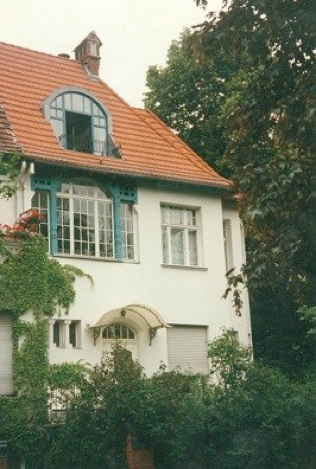
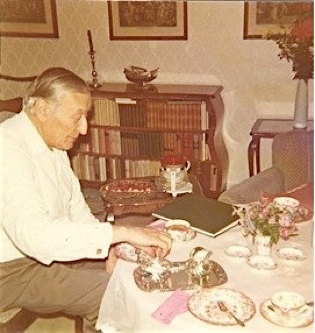
The house at Erdener Straße 5 in Berlin-Grunewald
Walter Schulze-Mittendorff in his house, 1971
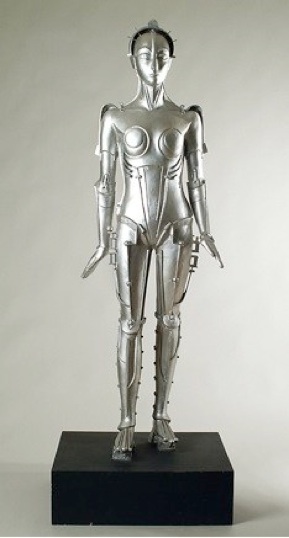
The Metropolis Robot,
Replica by Walter Schulze-Mittendorff, 1972
©: Cinémathèque française,
Photo by Stéphane Dabrowski
At this time the design itself presents a certain problem, too, since it is meant to follow an original sample. And even though he had created the original himself, the memory has somewhat faded with the passing of time over the last decades, marked in part by war and terror. There are no documents of the Metropolis Robot in his possession and so the Cinémathèque Française sends him the relevant photo material. He sets up a workshop in his house, and there he recreates the Metropolis Robot for the second time. The work on this replication, with its idea having arisen in 1964, had taken five years for its realization. But it will eventually be eight years in all until in 1972 the reproduction of the Metropolis Robot is finally presented to the visitors of the Paris Film Museum at the Palais de Chaillot. Today this Metropolis Robot is seen in Paris at the Musée du cinéma, rue de Bercy.
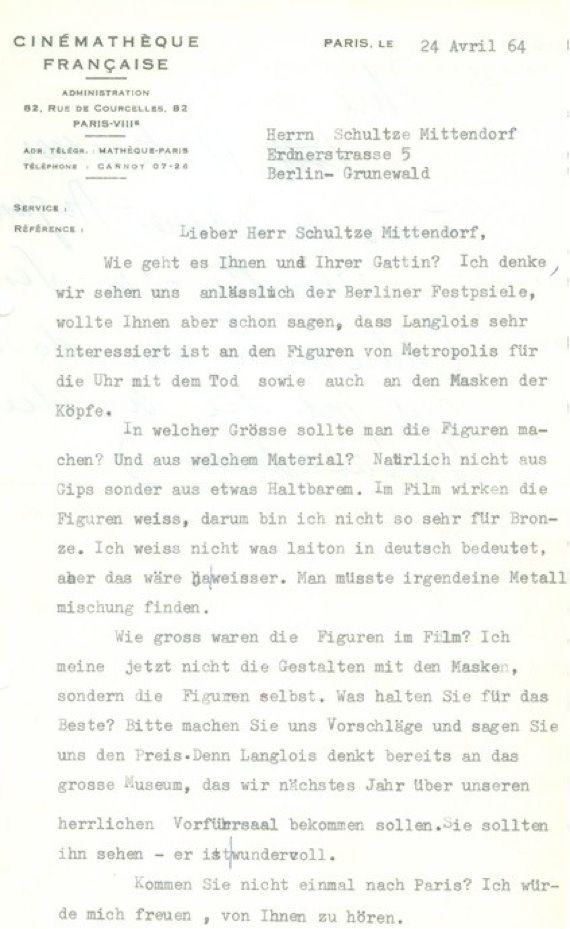
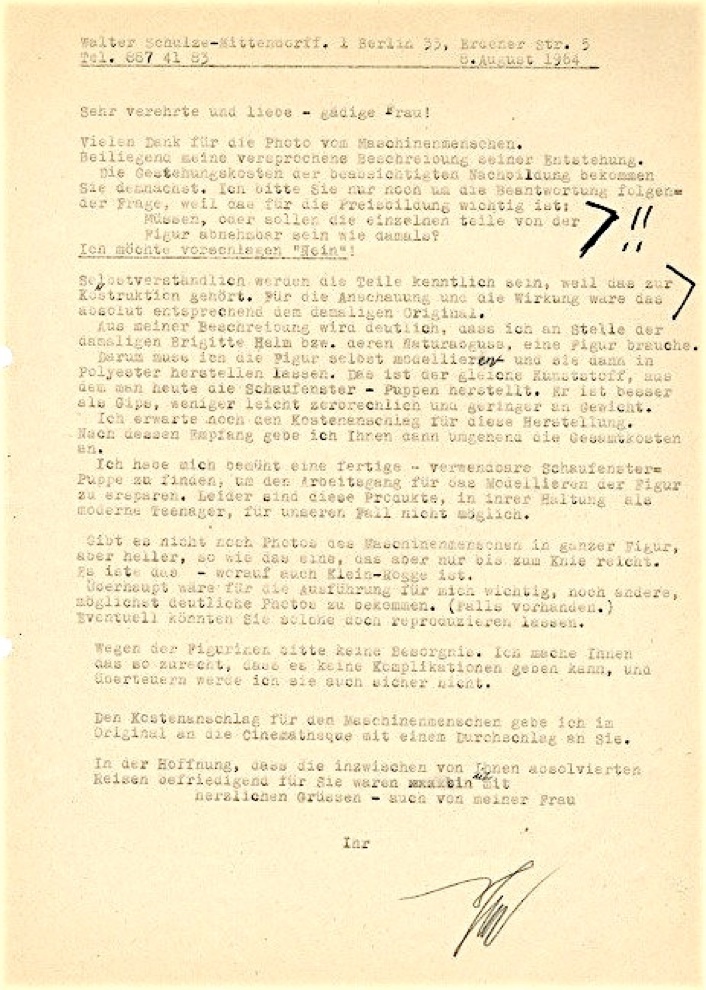
Draft for a letter by Walter Schulze-Mittendorff to Lotte Eisner from 1964
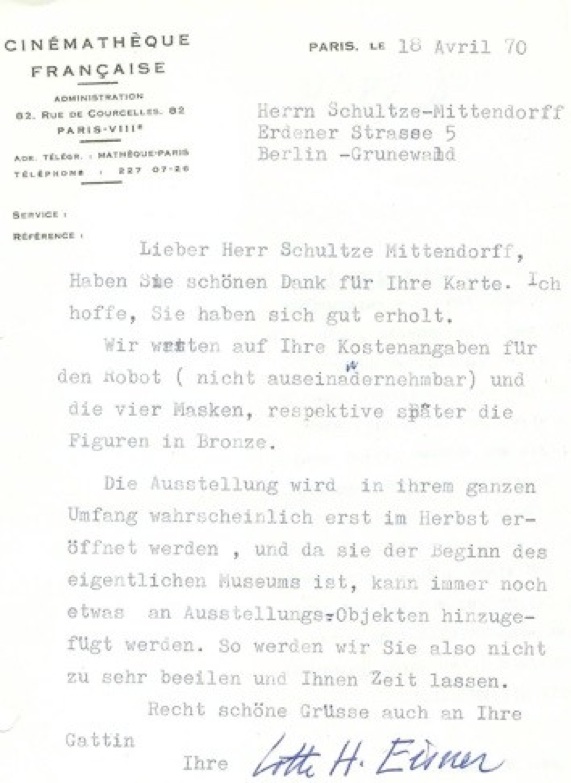
The two letters from Lotte H. Eisner date from 1964 and 1970. The „Figuren von Metropolis“ (“Figures from Metropolis”) and „Masken der Köpfe“ (“head masks”) referred to in the first letter, and the „Figuren aus Bronze“ (“bronze figures”) mentioned in the second letter refer to the figure group Death and the Seven Deadly Sins. Right after the first meeting, Lotte Eisner mentions that there is an interest in a „… Guss der Metropolis Figuren…“ (“… casting of the Metropolis figures…”)*, which means the figure group Death and the Seven Deadly Sins.
* Taken from a letter by Lotte Eisner of October 20, 1961










